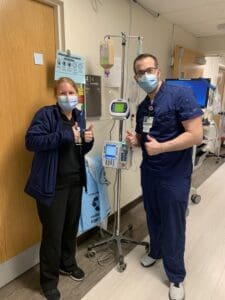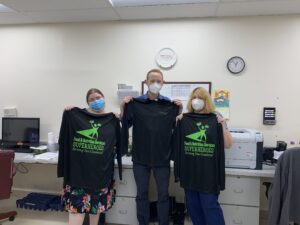Clinical Nutrition during COVID-19: Workflows and Staffing
COVID-19 has been difficult for healthcare providers across the globe. Through the difficulties of the past year, we have seen the growth of innovation and heroes. Dietitians play a crucial role in the health of our patients, especially during a pandemic. In a two-part series, we are taking a look at Clinical Nutrition to see the challenges and successes from their perspective. In our second piece, we discuss workflows and staffing.
Healthcare is about teamwork. Individuals can do great things, but together caregivers can become a unified source of healing. COVID-19 has amplified this need for collaboration. Never has it been more important to work across departments and utilize a holistic view of patient care. Through this, clinical nutrition has earned a seat at the table.
Christie Griffin has seen it firsthand. As the regional clinical nutrition manager for Baptist Memorial Hospital, she has seen her team come together to solve new challenges by working closely with other departments, particularly physicians.
“It’s been fun to see them get excited and collaborate with other departments,” said Griffin. “Clinical collaboration has become more important during a pandemic. Our dietitians have developed their own voices and been empowered.”
Collaboration is a tie that binds successful teams. Clinical nutrition faces numerous challenges during a pandemic. In a fast-paced healthcare environment where new information is constantly flowing, the clinical nutrition team can overcome obstacles by working together to optimize workflows and ensure proper staffing.
Workflows During a Pandemic
As the healthcare industry works to create high-reliability organizations, developing consistent and efficient processes is necessary to see quantifiable improvements across the spectrum of care. By investing time and resources in workflow development, hospitals can better care for patients. COVID-19 has forced clinicians to rethink previous processes and develop new ways to care for patients.

Nancy LaGuardia, regional clinical nutrition manager for Hackensack Meridian Health Ocean Medical Center, was forced to make big changes when COVID-19 hit New Jersey. As the state became a hot spot for outbreaks, LaGuardia’s hospital saw drastic increases in critically ill patients and ventilator-dependent patients. On average, the hospital had 10 patients on tube feeding before the pandemic. Now, they see as many as 55 daily.
That has led to changes in workflows in order to maximize her team’s and the hospital’s resources.
“This is not cookie-cutter,” said LaGuardia. “We have to look at each patient’s situation and come up with the best course of action.”
As expected, along with increases in critical care, the number of isolation rooms increased. Per hospital protocols, patient dining associates did not deliver to isolation rooms, relying on nursing to distribute meals.
“We lost a critical point of contact,” said LaGuardia. “It’s important for us to see how a patient is eating. COVID causes a number of challenges including loss of taste and shortness of breath. As a result, a lot of trays went untouched.”
LaGuardia and her team tried to find ways to make meals more appetizing and develop processes that adhered to the new reality of care. This included creating new menus for isolation rooms that included food that could be served at room temperature—an important distinction to make food distribution easier on nursing during a bundled care scenario.
They also developed flyers to accompany meals, explaining what is on the tray and why it is important to consume the food for the patient’s wellness and healing. Food is medicine and it is important to communicate that clearly to patients. Additionally, the clinical nutrition department provided contact information so patients could connect with dietitians to discuss their food preferences and needs, which is a step toward recreating the lost contact points.
At Baptist Memorial Hospital, Griffin and her team collaborated with physicians to develop new tube feeding protocols. It can sometimes be challenging to coordinate tube feeding management with providers. During a pandemic and surging census, clinical nutrition needs were a priority. Griffin and her team developed a new feeding protocol that helped physicians and clinical nutrition work together. The new and improved workflow also led to greater collaboration with the pharmacy department, who, in turn, initiated more conversations with the clinical nutrition department about dosing and feeding.
Staffing is Key for Clinical Nutrition Teams
Staffing remains a challenge for clinical nutrition. Like other areas of the hospital, departments often feel perpetually short-staffed as associates take medical leave or the hospital puts a step-down staffing model in place. With long hours and increased stress, burnout is also a major concern. But leaders are finding ways to engage their teams and create a culture of self-care.
“We have a close-knit team,” said LaGuardia. “We look to bring people in that have a teamwork mentality. It’s something that we’ve really relied on this past year. There have been so many challenges between home and work life. When we see someone fall, we’re there to pick the person up.”
At Bon Secours Maryview Medical Center in Portsmouth, Va., Julia Oblein made sure her team of dietitians was fully engaged and cross-supporting each other. Sister hospitals saw this same level of support as clinical nutrition teams across Morrison Healthcare worked together to find solutions to best care for patients.
“We didn’t increase staff directly,” said Oblein. “To address the increase in tube feeding patients, we freed up our dietitians who specialize in critical care, allowing them to focus on the sickest patients.”
Hospitals around the country found unique ways to address staffing. It required a constant juggling of schedules and duties, as well as flexibility.
 “Our team never fell behind, regardless of the scenario,” said Rebecca Mace, regional clinical nutrition manager for two hospitals in South Florida. “We planned ahead and looked for ways to be prepared for the unexpected. That gave our team a little flexibility and helped us to make sure our jobs are being fulfilled to the highest level.”
“Our team never fell behind, regardless of the scenario,” said Rebecca Mace, regional clinical nutrition manager for two hospitals in South Florida. “We planned ahead and looked for ways to be prepared for the unexpected. That gave our team a little flexibility and helped us to make sure our jobs are being fulfilled to the highest level.”
COVID-19 has led to drastic changes across healthcare. There have been challenges and stress, but there has also been innovation and empathy. Clinical nutrition has risen to the challenge. By putting the patient first, dietitians have redefined excellence and served as a steadfast example of excellent care. As part of this journey, dietitians have found a new, more powerful voice.
“Dietitians have started to look outside their normal practice,” said Griffin. “They have a full picture of what is happening and how they can better care for patients. For clinical nutrition, that will improve care and outcomes.”




